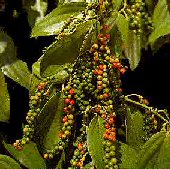Bring in the New year with a little corny corn! Black Peppercorn, that is! If you’re thinking “why is she writing about boring old Pepper? Duh! I already know everything about that little black speck,” well, read on! I’m fixing to change your way of thinking about our friend, Mr. Peppercorn.
Mr. Peppercorn is the dried, unripe berry fruit of the flowering vine Piper Nigrum. Yes, he comes from a fruit plant! Teachers across the world, rejoice! If you’re sick of apples, perhaps a “Peppercorn a Day will keep the Doctor Away”! The most common fruits of this fruits labor is ground black pepper, commonly found in a tin can. I’m certain Mr. Peppercorn will agree: This interpretation of the Peppercorn’s true seasoning capabilities is neglectful abuse at best, and a criminal offense punishable in a court of law, at least! I implore you: Make a mad dash to your spice cabinet and haul that can of black pepper as far away from your precious recipes as possible! Then either go to the store and purchase a pepper mill, or finally put to use that mortar and pestle, still in the box. From your wedding. 20 years ago....before they had fancy registries and whatnot.
Grinding your own pepper might sound tedious, especially when you’re used to a tin can doing all the work. However, the benefits of citrusy, floral, woody freshly ground peppercorns far outweigh the mild extra bit of work it takes to produce them. The better quality, and usually higher price tag of a premium Peppermill can equal up to seven times the amount of product per turn of the mill, so invest wisely! I recently purchased a moderately priced mill, whereas previously I was using the disposable kind found in the spice aisle at the grocery store. Huge difference! I can now spend more of my time in the kitchen sipping wine, instead of grinding pepper with a cheap contraption. See? The benefits of investing a few dollars beforehand far outweigh the initial slight dwindling of funds.
 In addition to being super cool, calm, and collective black pepper is a super food as well. It’s many health benefits include aiding in digestion, having duiretic properties, and impressive antioxidant and antibacterial effects. It is also thought to alleviate hemorrhoids, constipation, and gas. Thank you, Mr. Peppercorn! You taste good, look good, and make me feel good, too! I love you :)
In addition to being super cool, calm, and collective black pepper is a super food as well. It’s many health benefits include aiding in digestion, having duiretic properties, and impressive antioxidant and antibacterial effects. It is also thought to alleviate hemorrhoids, constipation, and gas. Thank you, Mr. Peppercorn! You taste good, look good, and make me feel good, too! I love you :)







